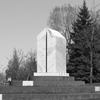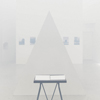 |
 |
||||
| images | installation views | ||||
| book-info | book-voices |
Mountains and Valleys, 2011-2017
Mixed medium, 38 + 1 inkjet prints, 24k gold leaf, folded paper, sound played in random loop, haze
Sound / Voices : Claudia Squitieri and Samon Takahashi
Matters that matter, set in stone, sit still. Cities speed around them in an accelerated pace together with shifting tides of significations. Monuments meant to make a permanent mark in the collective memory, become over time ever more abstracted and mute for many. What was to securely contain the past in the present, begins to merge into the constantly redrawn landscape of sharp edges and straight lines, cuts and grids. Declarations of peace and commemorations of tragedies morph into signs and sites simultaneously invisible amidst mundane urban flow and potent for divergent appropriations. They lie in waiting, for the rituals political and personal, regularly recurring ones as well as those yet to be given rise to. Calls for monuments to fall intensify today. The ongoing role of numerous statues in quietly legitimating oppressive regimes such as colonial power structures has recently been unveiled. Yet what orders do the columns and pyramids, together with various other non-representational forms, serve through their insistent repetition around the globe? Are these the standing stones of our time and civilization that future archaeologists of some kind may in vain attempt to make sense of? What are the common values carved and polished into the rocks, in their austere geometrical shapes? When the ideals of universal humanism and its grounding mathematical principles may no longer hold, in whose name will these cosmic references then speak? While the forms themselves appear silent today, calling for the activation of their scripts, one day only the rock will remain to read and relate to. The interwoven narratives of both chance encounters and communal gatherings envelope the monuments, yet their capacity to centre and solidify is troubled by this growing density. It is no longer possible to focus. Contrasts begin to melt, distances blur, coordinates go adrift. As the perspectival gaze has nowhere to fix itself anymore, how to feel the way now?
Taru Elfving (September 2017)
|